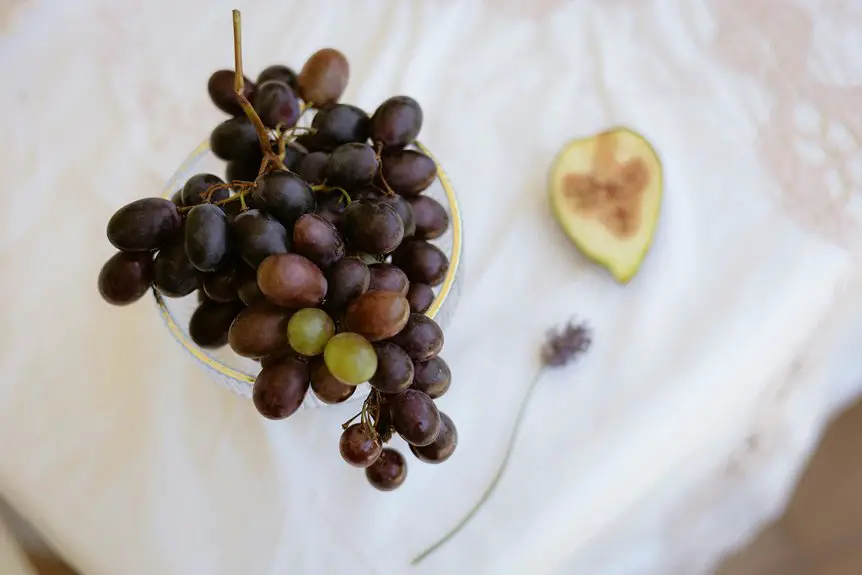If you’re looking for a breathable summer fabric, ramie is an excellent choice. Its long, strong fibers allow air to flow freely, keeping you cool even on hot days. Ramie absorbs moisture quickly and dries faster than cotton, preventing that sticky feeling. Plus, it resists wrinkles and holds its shape well, so you’ll stay comfortable and fresh. Curious how it stacks up against other summer fabrics and care tips? There’s more to explore.
Table of Contents
Key Takeaways
- Ramie fabric’s coarse texture and loose weave allow excellent airflow, making it highly breathable for hot summer days.
- It naturally absorbs 20-30% of moisture and dries faster than cotton, keeping skin dry and comfortable.
- Ramie wicks moisture away from the body, promoting evaporation and maintaining a fresh feeling in humid conditions.
- Its durability and shape retention ensure long-lasting comfort without excessive wrinkling or wear in summer use.
- The smooth surface of ramie reduces skin irritation, enhancing comfort during prolonged heat exposure.
Understanding Ramie Fiber Structure
Although you mightn’t be familiar with ramie fiber, it’s a natural vegetable fiber derived from the stalks of the ramie plant.
When you look closely at its structure, you’ll notice it has long, strong, and fine filaments. This crystalline structure gives ramie its notable strength and durability, even stronger than cotton in many cases.
Its fibers have a smooth surface and are highly absorbent, which helps wick moisture away from your skin. Because of this, ramie allows air to flow freely, keeping you cool and comfortable.
You’ll find that ramie also resists wrinkling and holds its shape well, making it ideal for summer wear. Understanding these qualities helps you appreciate why ramie fabric performs so well in warm weather.
Comparing Ramie to Other Summer Fabrics
When you choose summer fabrics, understanding how ramie stacks up against cotton, linen, and rayon can help you make smarter wardrobe decisions.
Ramie shares linen’s crisp texture and natural sheen but tends to be stronger and less prone to wrinkling. Compared to cotton, ramie feels lighter and more breathable, offering a cooler wear in hot weather.
Rayon, while soft and smooth, lacks the durability and natural fiber appeal of ramie. Unlike synthetic blends, ramie’s plant-based origin makes it more eco-friendly, which matters if you care about sustainability.
Knowing these distinctions allows you to pick fabrics that balance comfort, style, and practicality during summer’s heat without compromising on breathability or appearance.
Moisture Absorption and Wicking Properties
Moisture management plays an essential role in keeping you comfortable during hot summer days, and ramie fabric excels in this area.
It naturally absorbs moisture from your skin, helping you stay dry and cool. Unlike some fabrics that trap sweat, ramie pulls moisture away, which prevents that sticky, uncomfortable feeling.
Here’s what makes ramie great for moisture handling:
- High absorbency: Ramie can absorb up to 20-30% of its weight in moisture without feeling wet.
- Quick drying: The fabric dries faster than cotton, reducing the chance of dampness.
- Natural wicking: It draws moisture away from your body, promoting evaporation and comfort.
With these properties, ramie keeps you feeling fresh, making it a smart choice for summer wear.
Airflow and Ventilation Characteristics
Because ramie fibers have a naturally coarse texture and a loose weave, they allow air to flow freely through the fabric.
When you wear ramie clothing, you’ll notice how easily fresh air circulates, helping to keep your skin cool and dry. This ventilation prevents heat buildup, making ramie an excellent choice for hot, humid days.
Unlike tightly woven fabrics that trap heat, ramie’s structure encourages continuous airflow, so you won’t feel stifled. Whether you’re outdoors or in a stuffy room, ramie helps regulate your body temperature by promoting breathability.
Durability and Comfort in Hot Weather
Although you might expect lightweight fabrics to sacrifice strength, ramie stands out for its impressive durability. You’ll find it resists wear and tear better than many summer fabrics, making it a reliable choice for your warm-weather wardrobe.
Plus, ramie’s natural stiffness helps it hold shape, so your clothes look fresh longer.
When it comes to comfort in hot weather, ramie excels because:
- It wicks moisture away from your skin, keeping you dry.
- Its breathability prevents overheating by promoting good airflow.
- The fabric has a smooth texture, reducing irritation even on sensitive skin.
Styling and Care Tips for Ramie Clothing
Beyond its durability and comfort, ramie fabric offers unique qualities that influence how you style and care for it. You’ll notice its natural sheen and crisp texture give your summer outfits a polished look.
Pair ramie tops or dresses with soft cotton or linen for a balanced, breathable ensemble. Since ramie wrinkles easily, embrace a relaxed, slightly rumpled style or steam your clothes to maintain crispness.
When it comes to care, wash ramie garments gently in cold water with mild detergent to preserve their fibers. Avoid wringing or twisting; instead, blot excess water and lay flat to dry.
Iron on a low to medium setting while the fabric is damp to smooth wrinkles effectively. With these tips, you’ll keep your ramie pieces looking fresh and stylish all summer long.
Frequently Asked Questions
Is Ramie Fabric Hypoallergenic for Sensitive Skin?
You’ll find ramie fabric gentle on sensitive skin because it’s naturally hypoallergenic and breathable. It resists bacteria and moisture buildup, so you won’t experience irritation or itching, making it a great choice if you have allergies.
Can Ramie Fabric Be Blended With Synthetic Fibers?
Think of ramie blending with synthetics like a dance—yes, you can mix them! Combining ramie with fibers like polyester enhances durability and wrinkle resistance, giving you fabric that’s both strong and comfortable for everyday wear.
How Eco-Friendly Is Ramie Cultivation and Processing?
You’ll find ramie cultivation eco-friendly since it requires minimal pesticides and fertilizers. Processing is mostly natural, but some chemical use can occur. Overall, it’s a sustainable option if handled with care during production.
Does Ramie Fabric Shrink After Washing?
You might wonder if ramie fabric shrinks after washing—here’s the twist: it can, especially with hot water or high heat drying. To keep it intact, always wash cold and air dry gently.
What Is the Cost Comparison of Ramie Versus Linen?
You’ll find ramie fabric generally costs less than linen due to its easier cultivation and processing. While both offer great quality, ramie’s affordability makes it a budget-friendly alternative without sacrificing durability or comfort.
- Does Chiffon Fabric Stink - July 15, 2025
- Does Chiffon Fabric Affect the Economy - July 15, 2025
- Does Cotton Fabric Have a Nap - July 15, 2025







